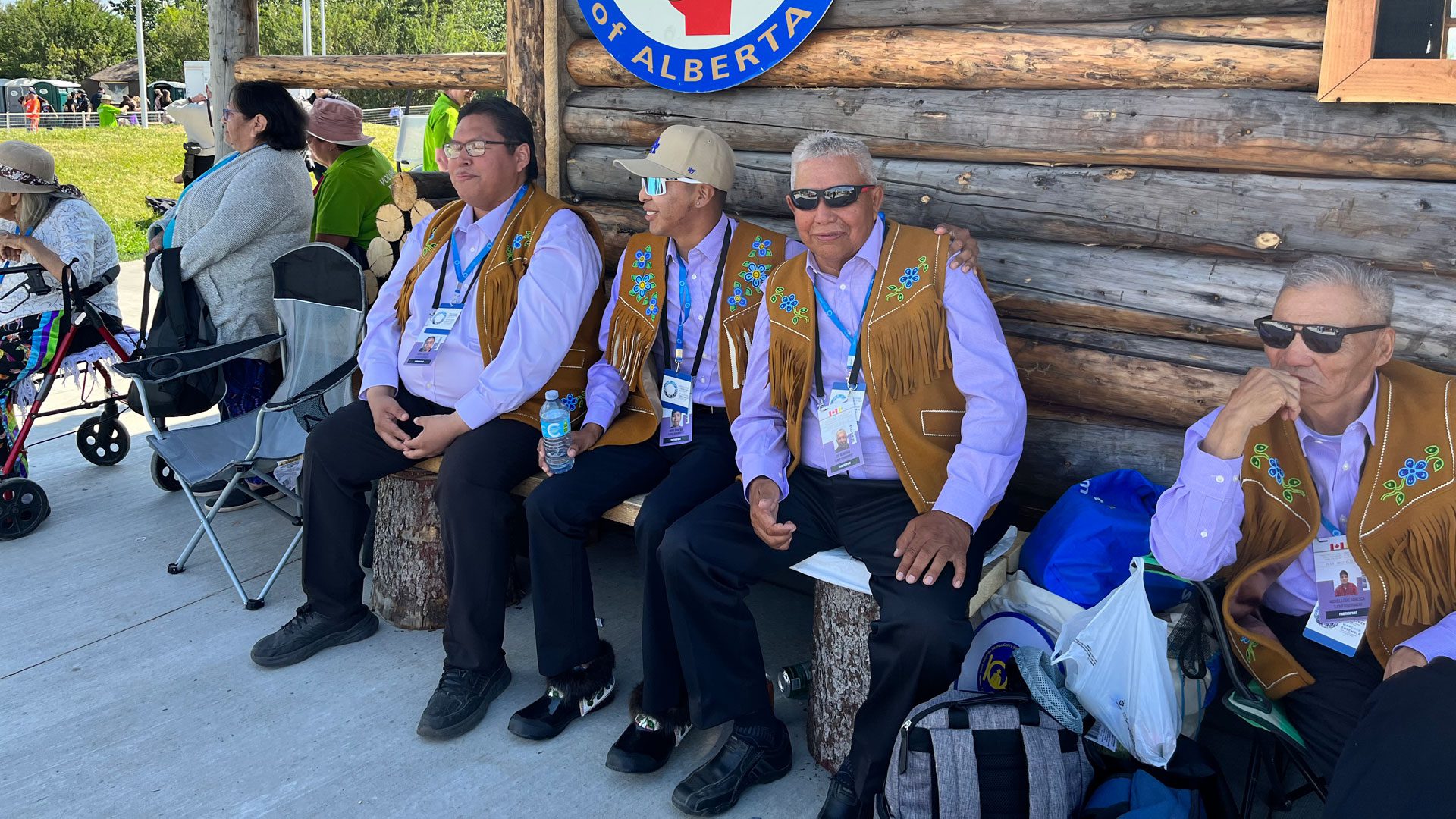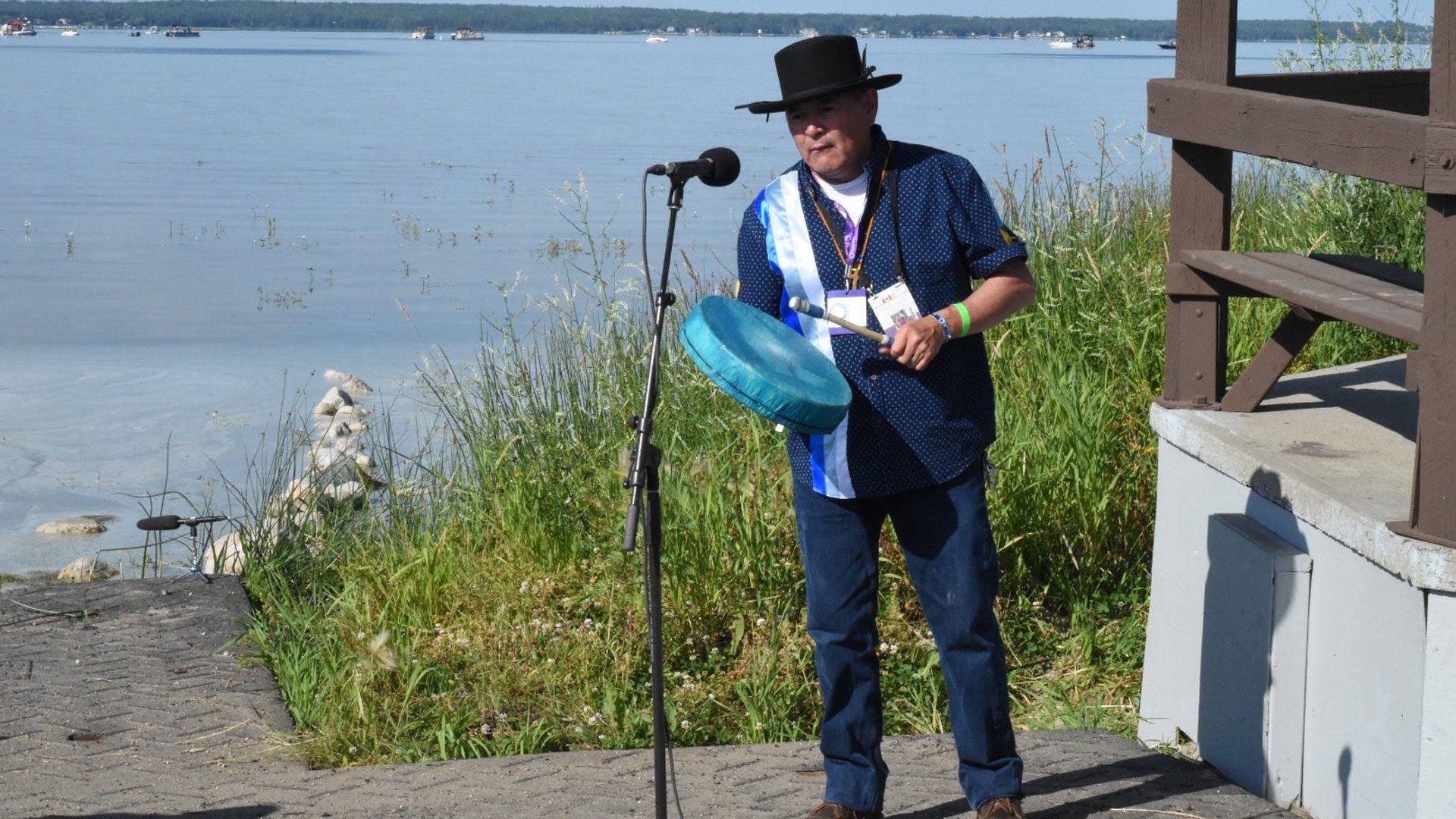People arrived early at the lake. In contrast to the high emotions of Maskwacis, the feeling at Lac Ste. Anne was relaxed and celebratory.
For those present before the arrival of the Pope’s motorcade there was drumming, singing and a presentation on murdered and missing Indigenous women and girls.
When he arrived, Pope Francis began his journey with a customary stop at the statue of St. Anne.
The Pope then proceeded to the lake to begin his prayer.
The Tkitcho drummers accompanied him on his walk. A few hours before they sat in the shade of the Métis cabin, excited for their performance.
Tony Rabisca, one of the drummers, has been coming with grandparents and elders for years and is looking forward to Pope’s visit.
“I am looking forward to doing the prayer song, it has a powerful spirit of prayer and healing,” he says. “As a group, we discussed why we are doing this – it is because of the suffering of the residential schools.”
Rabisca said he’s also hoping for unity and healing for Indigenous Peoples.
“We need to unite together and pray for those who have been impacted by residential schools.”

The Tkitcho drum beat stopped as the Pope neared the water and then a solo drum, played by Eugene Alexis began to play.
Alexis sang a song that had been heard by his ancestors as the Pope walked up.
As is customary for the Plains Cree, the Pope began his prayer facing east and prayed to the four directions.
He then blessed the lake and sprinkled the crowd, who could not come closer to the lake due to security protocols, with the water.
Before contact, people believed the waters at Lac Ste Anne held special healing powers.
In 1887, the site was established by Catholic priests as a place to worship. The first pilgrimage was in 1889.
Today, tens of thousands of people make the pilgrimage – some travel hundreds of kilometres by foot to get to the place held dear by modern-day Catholics.
Belief in the healing power of the water is unquestioned. A webpage is dedicated to the site – and a video was produced with testimonials of the lake’s healing powers.
The site is located about an hour west of Edmonton.

Coun. Aaron Paquette who is Métis-Cree is acting as the deputy mayor during the Papal visit, as the only Indigenous member of the Edmonton City Council.
His grandparents went to residential schools and his father was part of what is called the ’60s Scoop where tens of thousands of Indigenous children were forcibly removed from their parents and adopted out to non-Indigenous families.
Paquette says like everyone else, there’s been a mixture of emotions.
He says his thoughts are with survivors. “Right now it is just about taking it in, and bearing witness.”
Paquette says that healing isn’t going to come all at once.
“If there’s hope coming out of this it is going to come later,” he said.
For many present, the Pope’s apology was an affirmation that something was done to them, rather than that there was something wrong with them.
They were moved that the highest level of the Catholic Church was recognizing that the children in residential schools had been wronged.
Kenina Wood from St. Theresa Point First Nation brought her 18-year-old with her.
“I came here for my dad – I am a second-generation residential school survivor – my dad died when he was 35. I was 15 years old.”
Wood says “growing up I could feel that we had this hurt and something he could never fill.”

Her father, Darius Mason, would often tell her about being taken away from his parents when he was six years old.
As for the Pope’s apology she says she has felt a bit of healing but would like to see more from the church. She would like to see the work of reconciliation continue. That said, she is not looking for prosecutions for any of the abuse.
“I don’t want to wish more harm to be passed on I want to stop the cycle,” says Wood.
She is there with her uncle, Marcel Mason.
He went to three different residential schools in Manitoba. He says he recalls a lot of abuse, but he has tried to keep a positive outlook in life.
As for reparations or payment to First Nations, he doesn’t think that is the answer.
“Money is not going to heal anything as far as I am concerned, it comes and goes right away,” says Mason.
At the very end of the Pope’s visit, Jane Weyallon-Armstrong, a former member of the legislative assembly of the Northwest Territories stands to bid farewell to the Pope.
She is radiant and holding a shirt that reads ‘I Heart Pope Francis.’
“I want to heal and want to move forward,” says Weyallon-Armstrong. “I want things to be better for our youth and young people.”
As the Pope drives by waving at the crowd, Weyallon-Armstrong lines up to hold up the shirt so the Holy Father can see it.
Commonwealth Stadium: Drummers, singers and empty seats

Earlier on Tuesday, Pope Francis held a mass at Commonwealth Stadium in Edmonton.
Although there were reportedly 65,000 tickets given out by the time the Papal Visit Choir started, the stadium, the largest open-air facility in Canada with a seating capacity of 56,302, was less than half filled.
According to the Vatican as of 2020, there were approximately 207,000 parishioners in the Archdiocese of Edmonton. The tickets were free, but there were reports of the tickets being re-sold for up to $200.
The gate count for participants was 31,323. People were moved from a nearby venue which was intended to be an overflow site, to help fill seats.
A welcome video from Fr. Cristino Bouvette, national liturgical coordinator for the Papal visit, welcomed people to the stadium on the day of the Feast of Ste. Ann.
This is a day that celebrates the feast of the grandparents of Jesus Christ.
The first reading came from Pam Kootnay, from Enoch First Nation. The theme of the Pope’s homily was on grandparents and the importance of respect for elders.










